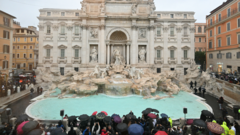Rome's iconic Trevi Fountain, a baroque masterpiece that draws thousands of tourists daily, has recently re-opened after completing a comprehensive three-month restoration. The fountain, originally designed in the 18th century by architect Nicola Salvi and located at the Poli Palace, sees daily foot traffic ranging from 10,000 to 12,000 visitors.
In response to the overwhelming crowds, the city's authorities have implemented a new queuing system designed to ensure a more manageable flow of tourists around the fountain. During the re-opening event, Rome's mayor, Roberto Gualtieri, highlighted that these measures aim to allow visitors to fully appreciate the landmark without the hassle of overcrowding. He also mentioned potential plans to charge a small entry fee to aid in the fountain's ongoing maintenance and restoration needs.
The fountain's revival involved extensive cleaning efforts to eradicate mold and calcium deposits, which had marred its intricate design. This effort comes just in time as the city prepares for the upcoming jubilee of the Roman Catholic Church, beginning on Christmas Eve.
Historically significant, the Trevi Fountain was commissioned by Pope Clement XII in 1730 and is the culmination point of the Acqua Vergine aqueduct, which has supplied ancient Rome with water since 19 BC. Folklore suggests that thirsty Roman soldiers were led to the water source by a virgin girl, giving rise to its name, "Virgin Waters."
The fountain is not only a sight to behold but also features a tradition of coin tossing, popularized by the 1954 film "Three Coins in the Fountain." It is estimated that approximately €10,000 per week is generated from these coins, which are donated to charities supporting the less fortunate. Visitors can also quench their thirst at a drinkable water tap located discreetly nearby.






















